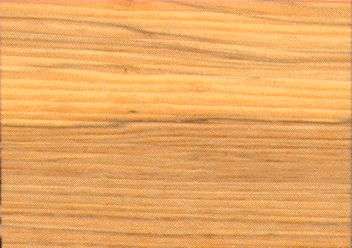
Andamans ash (Terminalia bialata)
Family: Combretaceae
Common names: Andamans ash, Chieu-lieu, Chuglam, Chuglam white, Indian silver grey wood, Lein, Safed chuglam, White chuglam
Common uses: Boat building (general), Boxes and crates, Cabinetmaking, Flooring, Furniture, Handles: general, Heavy construction, Joinery, Light construction, Mathematical instruments, Mine timbers, Musical instruments, Musical instruments: piano, Oars, Paneling, Plywood, Poles, Pulp/Paper products, Railroad ties, Roofing, Structural work, Tool handles, Vehicle parts, Veneer, Veneer: decorative
Tree size: Tree height is 30-40 m
Colors: the heart isWhite to cream, Yellow to golden-yellow to orangeand the sapwoodWhite to yellow, Yellow.The grain isVariable figure, the textureMedium coarse to coarseand the lusterMedium
Natural durability: Susceptible to attack from termites (Isoptera), Susceptible to insect attack
Kiln Schedules: UK=E US=T6D2/T3D1 Fr=5
Kiln Drying Rate: Drying rate is fairly rapid to fast
Drying Defects: Slight surface checking, Splitting
Ease of Drying: Moderately Difficult to Difficult
Tree Identification: Bole/stem form is buttressed
Comments: General finishing qualities are rated as good
Blunting Effect: Moderate
Boring: Fairly easy to very easy
Carving: Fair to Good Results
Cutting Resistance: Moderate to saw
Gluing: Fairly Easy to Very Easy
Mortising: Fair to Good
Moulding: Fairly Easy to Very Easy
Movement in Service: Fairly Easy to Very Easy
Nailing: Pre-Boring Recommended, Very Good to Excellent
Planing: Very Good to Excellent
Resistance to Impregnation: Resistant sapwood
Response to hand tools: Responds Readily
Routing recessing: Fairly Easy to Very Easy
Sanding: Fairly Easy to Very Easy
Veneering qualities: Suitable for slicing, Suitable for slicing
Screwing: Satisfactory screwing finish, Very Good to Excellent Results; Turning: Fairly Easy to Very Easy
Polishing: Surface Preparation; Staining: Very Good to Excellent;
- Numerical data Metric
- Numerical data English
- Strength properties
- References
 |
 |
 |
 |
| Item |
Green |
Dry |
Metric |
| Specific Gravity |
|
|
|
| Density |
|
673 |
kg/m3 |
| Bending Strength |
542 |
849 |
kg/cm2 |
| Crushing Strength |
275 |
449 |
kg/cm2 |
| Hardness |
|
692 |
kg |
| Impact Strength |
|
101 |
cm |
| Shearing Strength |
|
77 |
kg/cm2 |
| Stiffness |
110 |
127 |
1000 kg/cm2 |
| Tangential Shrinkage |
|
|
% |
| Radial Shrinkage |
4 |
|
% |
| Weight |
657 |
528 |
kg/m3 |
| Maximum Load |
|
|
cm-kg/cm3 |
| Toughness |
|
|
cm-kg |
| Static Bending |
|
|
kg/cm2 |
|
 |  |  |  | | Item | Green | Dry | English | | Bending Strength | 7711 | 12078 | psi | | Density | | 42 | lbs/ft3 | | Hardness | | 1526 | lbs | | Impact Strength | | 40 | inches | | Maximum Crushing Strength | 3916 | 6397 | psi | | Shearing Strength | | 1107 | psi | | Stiffness | 1573 | 1816 | 1000 psi | | Weight | 41 | 33 | lbs/ft3 | | Radial Shrinkage | 4 | | % | | Tangential Shrinkage | 6 | | % | |
Max. crushing strength = medium 1
Density (dry weight) = 38-45 lbs/cu. ft. 0
Modulus of Elasticity (stiffness) = medium
Bending strength (MOR) = medium
Bending strength (MOR) = low
Shrinkage, Tangential = moderate
Hardness (side grain) = medium
Toughness-Hammer drop (Impact Strength) = medium
Shrinkage, Radial = fairly large
Modulus of Elasticity (stiffness) = low
Shrinkage, Radial = moderate
Shearing strength (parallel to grain) = very low
Density (dry weight) = 46-52 lbs/cu. ft.
Shrinkage, Tangential = very small
Shrinkage, Tangential = small
Shrinkage, Radial = very small
Shearing strength (parallel to grain) = low
Hardness (side grain) = soft
Density (dry weight) = 53-60 lbs/cu. ft
Chudnoff, M.,1984,Tropical Timbers of the World,U.S.A. Department of Agriculture, Forest Service, Forest Products,Laboratory, Madison.Clifford, N.,1953,Commercial Hardwoods - Their Characteristics Identification and,Utilization,Sir Isaac Pitman & Sons Ltd. LondonClifford, N.,1957,Timber Identification for the Builder and Architect,Leonard Hill (Books) LTD. LondonCox, H.A.,1939,A Handbook of Empire Timbers,Forest Products Research Laboratory, Princes RisboroughDas Gupta, P.R.,1980,Studies on differential shrinkage in different planes of wood,Indian Forester 106(2) pp128-40Farmer, R.H.,1972,Handbook of Hardwoods,HMSOForests Products Research Laboratory, U.K.,1956,A Handbook of Hardwoods,Forest Products Research Laboratory, Princes Risborough, Department of,Science and Industrial Research, Building Research EstablishmentGamble, J.S.,1902,A Manual of Indian Timbers,Sampson Low, Marston & Co. LondonHoward, A.L.,1948,A Manual of Timbers of the World.,Macmillan & Co. Ltd. London 3rd ed.Limaye, V.D.,1933,The Physical and Mechanical Properties of woods grown in India (Third,Interim Report on Project 1,Indian Forest Records,18(10,pp1-70Patterson, D.,1988,Commercial Timbers of the World, 5th Edition,Gower Technical PressPearson, R.S., Brown, H.P.,1932,Commercial Timbers of India,Govt. Printer Calcutta,2 volsRamesh, Rao K., Juneja, K.B.S.,1971,Field Identification of Fifty Important timbers of India,Dehra Dun IndiaRamesh, Rao K., Purkayastha, S.K.,1972,Indian Woods - Their Identification Properties and Uses,Dehra Dun India,Vol. 3Rendle, B.J.,1969,World Timbers (3 Vols.,Ernest Benn Ltd. LondonTewari, M.C., Jain, J.C.,1980,Utilization of Secondary Species,Journal of the National Building Organization 25(2) pp1-6Timber Development Association Ltd.,1955,World Timbers (3 Vols.,Timber Development Association Ltd.Titmuss, F.H.,1965,Commercial Timbers of the World,Technical Press Ltd., London, 3rd edition
|








